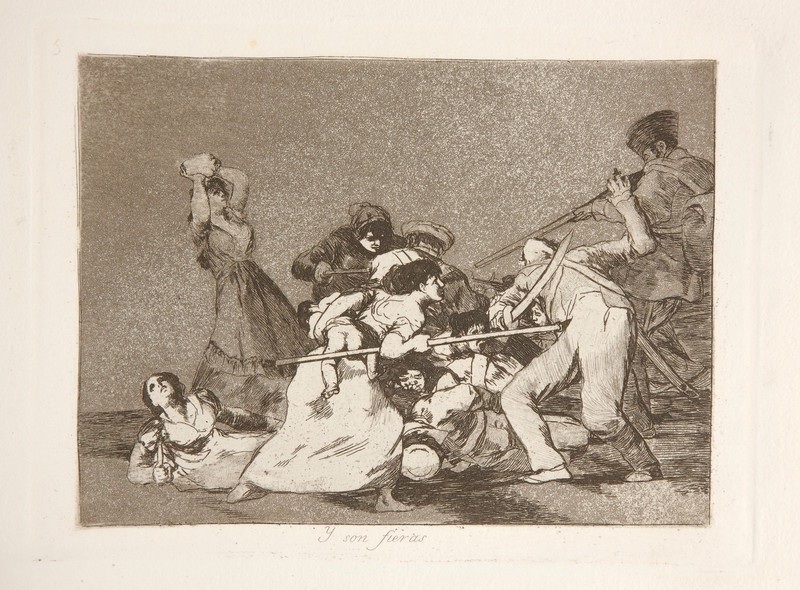- Cronología
- Ca. 1812 - 1815
- Dimensiones
- 156 x 208 mm
- Técnica y soporte
- Etching, burnished aquatint and drypoint
- Reconocimiento de la autoría de Goya
- Undisputed work
- Ficha: realización/revisión
- 25 Nov 2010 / 02 Jun 2023
- Inventario
- 225
28 (lower left-hand corner).
See Sad presentiments of what must come to pass.
In the second state proof we can see where the burnisher has been used on the upper part of the plate, on the body of the speared soldier and on the right thigh of the woman lying off to the left-hand side. Drypoint has been applied on the trousers of the speared soldier in the foreground. This state proof was made before the lettering was added and the additional aquatint was applied.
There exists another state proof, with the number 5 already engraved, in which the aquatint has been removed from the edges apart from in a small area at the bottom.
The title was handwritten by Goya on the first and only print run that we know to have been made at the time, and which the painter gave to his friend Agustín Ceán Bermúdez. The title was engraved on to the copperplate at a later date, and no other modifications were made to the image for the first edition of the Disasters of War, which was printed by the Royal Academy of Fine Arts of San Fernando, Madrid, in 1863.
No preparatory drawings for this print have been conserved.
In the foreground, a woman, with a child held under one arm, drives a spear into a soldier, mortally wounding him. Beside her, and slightly further back, another woman is lying on the ground, with a dagger clasped in one hand. In the middle ground, several figures are entangled in a vicious struggle on the ground: off to one side a soldier, shown in profile, takes aim with his rifle; a woman stabs a sword into a French soldier; and another holds a large stone over her head, ready to hurl it.
Just as in print no. 4, The women give courage, here Goya has used diagonal lines in the composition to produce a strong sensation of instability and movement. Only the prone woman, the woman on the left who is about to throw the stone, and the soldier aiming his gun on the right-hand side contribute any kind of stability to the scene, constituting a sort of parenthesis that serves to mark the edges of the situation. It is difficult to make out against whom the figures at the back are fighting. It almost seems as if they are all fighting against one another, as if they form part of the same wild mob, driven by a fervent, irrational violence.
Here aquatint has been used more moderately, with less intensity than in the previous print. The background is somewhat paler and the white surface of the two figures in the foreground helps to emphasize their importance.
Looking beyond the prevailing chaos of this image, Goya sets out to remind us of the prominence of women in the struggle, of their ferocity. Here, in And are like wild beasts, he continues with the theme of women's role in war that he began in print no. 4, The women give courage. In addition, the presence of the half-naked child, which the woman in the foreground carries under her arm, brings to mind the biblical story of the slaughter of the innocents.
The etching plate is conserved in the National Chalcography Museum (cat. 256).
-
GoyaMinistry of Foreing AffairsBurdeos1951organized by the Bordeaux City Hall, consultant editor Gilberte Martin-Méry. From May 16th to June 30th 1951cat. 4
-
Goya. Das Zeitalter der Revolucionen. Kunst um 1800 (1980 – 1981)Hamburger KunsthalleHamburg1980cat. 71
-
Goya y el espíritu de la IlustraciónMuseo Nacional del PradoMadrid1988from October 6th to December 18th 1988. Exhibited also at Museum of Fine Arts, Boston, January 18th to March 26th 1989; The Metropolitan Museum of Art, Nueva York, May 9th to July 16th 1989, Madrid curator Manuela B. Mena Marqués, scientific directors Alfonso E. Pérez Sánchez and Eleanor A. Sayrecat. 83
-
Francisco de GoyaMuseo d'Arte ModernaLugano1996exhibition celebrated from September 22nd to November 17th.cat. 5
-
Francisco Goya. Sein leben im spiegel der graphik. Fuendetodos 1746-1828 Bordeaux. 1746-1996Galerie KornfeldBern1996from November 21st 1996 to January 1997cat. 94
-
Ydioma universal: Goya en la Biblioteca NacionalBiblioteca NacionalMadrid1996from September 19th to December 15th 1996cat. 224
-
Francisco Goya. Capricci, follie e disastri della guerraSan Donato Milanese2000Opere grafiche della Fondazione Antonio Mazzottacat. 85
-
Goya's RealismStatens Museum for KunstCopenhagen2000from February 11th to May 7th 2000cat. 39
-
Goya. Opera graficaPinacoteca del Castello di San GiorgioLegnano2006exhibition celebrated from December 16th 2006 to April 1st 2007p. 53
-
Goya et la modernitéPinacothèque de ParisParís2013from October 11st 2013 to March 16th 2014cat. 44
-
Hamburg2019cat. 103
-
Agen2019cat. 61
-
2022
-
Goya, grabadorMadridBlass S.A.1918cat. 107
-
Goya engravings and lithographs, vol. I y II.OxfordBruno Cassirer1964cat. 125
-
Vie et ouvre de Francisco de GoyaParísOffice du livre1970cat. 998
-
Vicisitudes de algunas láminas grabadas por Francisco de Goya: Los desastres de la guerra, Los disparates, La tauromaquiaGoya1978-1979cat. 125
-
Goya y el espíritu de la IlustraciónMadridMuseo del Prado1988cat. 83
-
Catálogo de las estampas de Goya en la Biblioteca NacionalMadridMinisterio de Educación y Cultura, Biblioteca Nacional1996cat. 188
-
ParísPinacoteca de París2013p. 122
-
Goya. In the Norton Simon MuseumPasadenaNorton Simon Museum2016pp. 114-151
-
HamburgHirmer2019p. 312
-
AgenSnoeck2019p. 161
-
Museo de Bellas Artes de Badajoz y Diputación de Badajoz2022p. 54
